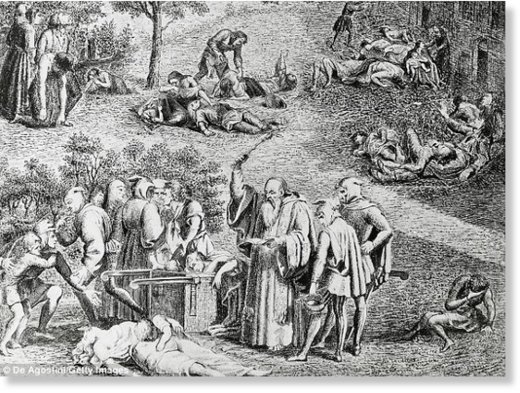Lead researcher Dr Ashok Chopra, whose research is being backed by the Department of Defense, warns the scenario is a more realistic prospect than we think. 'Terrorists can easily grow the bacteria and make the strains resistant to antibiotics,' Dr Chopra, a microbiologist and immunologist at the University of Texas microbiologist, told Daily Mail Online.
'The pneumonic plague is very contagious and very hard to treat. It could kill millions. 'Think of the Black Death of the 14th century. It is not unrealistic that we would experience the same number of mass casualties. It could be quite devastating.'
There are three strains of the plague - pneumonic, bubonic, and septicemic - all caused by bacteria called Yersinia pestis. The most common type is the bubonic plague, typically found on animals and transmitted to humans via fleas.
It was the bubonic plague that caused the Black Death, as well as America's first outbreak in 1900 when infected animals were imported from Asia to San Francisco. However, the pneumonic plague, which is airborne, is fatal almost 100 percent of the time.
Comment: Although a horrible disease, Bubonic plague is not the infamous Black Death that killed half of Europe's population in the Middle Ages, according to recent research. The latter was likely to be caused in part by pathogens brought to Earth by comets. See this book review for more information:
New Light on the Black Death: The Cosmic Connection
Crucially, all strains are hard to diagnose, with symptoms resembling a cold or the flu. Antibiotics is the only cure - but if it isn't administered in time, it is barely effective. And with strains of the plague already showing antibiotic resistance, experts warn we need to fast-track a back-up plan.
In fact, one strain has already proven resistant to chloramphenicol - a highly toxic antibiotic that is often used as a 'last resort'. Dr Chopra warns it is incredibly easy to repurpose the pneumonic plague, making it resistant to all antibiotics.
'It is really easy to grow the organism. You require a very low dose and not very sophisticated equipment,' he told Daily Mail Online. 'Antibiotic resistance is a major problem already, and terrorists can easily make strains antibiotic-resistant, so there should be alternates.'
'A vaccine is the best way because your immune system has already been triggered, so the pathogen should be killed.' Dr Chopra was among the scientists drafted in by the CDC to study anthrax after the anthrax attacks of 2001, when deadly bacteria were sent to congressional members by mail.
It was then that the CDC and NIH warned scientists to start looking at Yersinia pestis as one of the most malleable bioweapons. Fifteen years later in 2016, the World Health Organization upgraded the bacteria to a tier 1 pathogen - the highest level it could be, warning that it is an imminent threat.
Having studied Yersinia pestis since 2002, progress has been slow. But Dr Chopra insists we have reached significant milestones in the last few years.'We have tested two animal models and the results are promising,' he told Daily Mail Online.




Comment: For an even more in-depth study of cosmic forces at work, read Pierre Lescaudron with Laura Knight-Jadczyk's Earth Changes and the Human-Cosmic Connection